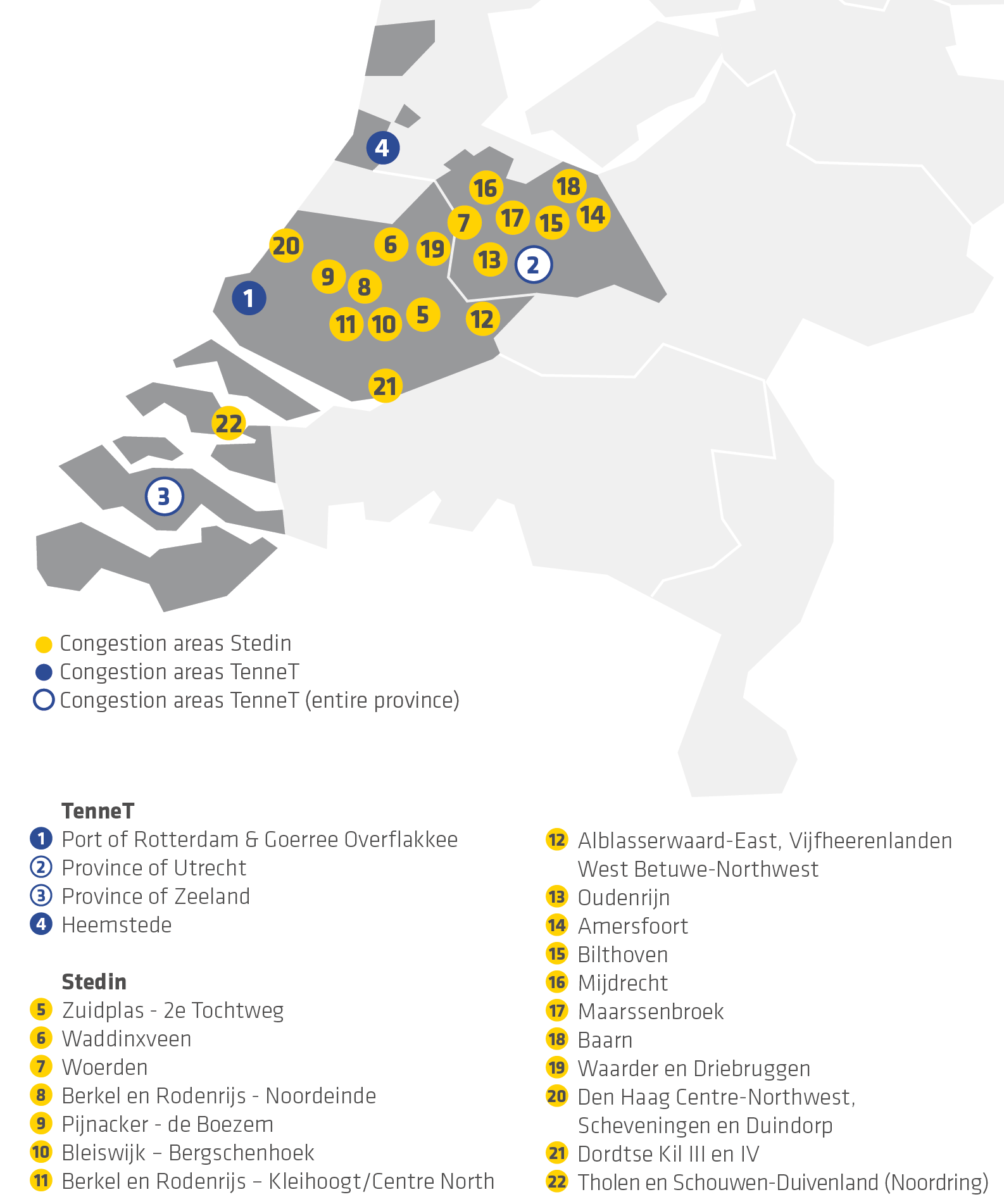Queues on the electricity grid: congestion
Grid congestion is like a rush hour queue on the power grid. Congestion means that the capacity limit of the power grid has been reached, or we expect this limit to be reached before we can realise the required expansion. Congestion may occur on the consumption side (electricity use) as well as on the feed-in side (electricity generation). It means that we are unable to offer new or existing customers any (additional) transmission capacity. Currently, only heavy-use customers are affected by our inability to allocate any new transmission capacity. However, households increasingly experience voltage problems.
In 2023, the number of congestion areas increased in both TenneT’s high-voltage grid and Stedin’s regional electricity grid. The overview of congestion areas below show the situation on 31 December 2023, when thee were 22 congestion areas (including TenneT’s). In the period between 31 December 2023 and the publication of this annual report, new congestion areas have emerged. We therefore refer to Stedin’s website for the most recent situation.

TenneT congestion areas in Stedin coverage area
The congestion areas on TenneT's national high-voltage grid in Stedin’s coverage area are: the Port of Rotterdam and surrounding regions, and the provinces of North-Holland, Zeeland and Utrecht.
Stedin congestion areas
In addition to congestion on the TenneT high-voltage grid, we are increasingly coming up against the limits of our own regional grid. In 2023, Stedin reported 16 new congestion areas on its own regional grid, in addition to the two areas in which we had previously reported congestion.
Whenever a shortage of transmission capacity occurs on the electricity grid, be it on TenneT's high-voltage grid or on our regional grid, we as the grid manager report this congestion to the regulator, the Netherlands Authority for Consumers and Markets (ACM). This may be congestion on the consumption side or congestion on the feed-in side, or a combination of the two. We can usually resolve congestion only by reinforcing the grid. And this, as mentioned earlier, takes time. Therefore, when we report congestion, we always also at the same time examine the options for congestion management, for example in Tholen and Schouwen-Duivenland (see box).
In addition, we are constantly working on technical and flexibility-related solutions. You can read more about this topic in the ‘Utilisation’ section.
Congestion management in Tholen and Schouwen-Duivenland (Noordring)
In 2023, Stedin carried out further checks, as well as a survey, to find out whether flexible electricity consumption could be deployed – on a voluntary basis – in order to free up capacity on the Tholen and Schouwen-Duivenland grid.
Following this call, we concluded contracts with three customers in the Noordring area on using ‘flexible capacity’ to feed in energy. All of the limited capacity freed up in this way is needed to facilitate the growth of consumer feed-in. Therefore, we are (as yet) unable to reduce the waiting list for heavy-use customers wanting to feed in renewable electricity.
Because more flexible capacity is needed, Stedin will take follow-up steps in 2024. In addition, Stedin and TenneT are making every effort to reinforce the electricity grid in Schouwen-Duiveland and Tholen. Among other things, additional stations will be built in Zierikzee and Tholen in the coming years, both of which will be connected to a new TenneT high-voltage station in Halsteren. TenneT announced in November 2023 that the additional stations could be put into operation in September 2028.
Waiting list
As a result of congestion, around 1,100 businesses and institutions were on our waiting list at year-end 2023 for connections. More than 800 customers were on the waiting list in Utrecht, about 160 in South-Holland, about 125 in Zeeland and 4 in North-Holland. In the case of 32% of the businesses on the waiting list, the request is for feed-in, with 68% waiting for consumption of electricity with a total capacity of around 650 MW.
In our coverage area, we have 99.9961% supply reliability. For customers on a waiting list, however, supply reliability is 0%. This is because they are not given the connection they need or cannot feed the electricity they (want to) produce into our grid. We very much regret the fact that we are unable to provide any new transmission capacity. We make every effort to prevent congestion, accelerate construction and operate our grids as efficiently as possible. The results we achieved in this respect in 2023 are described in the ‘Full focus on further acceleration’ section.
